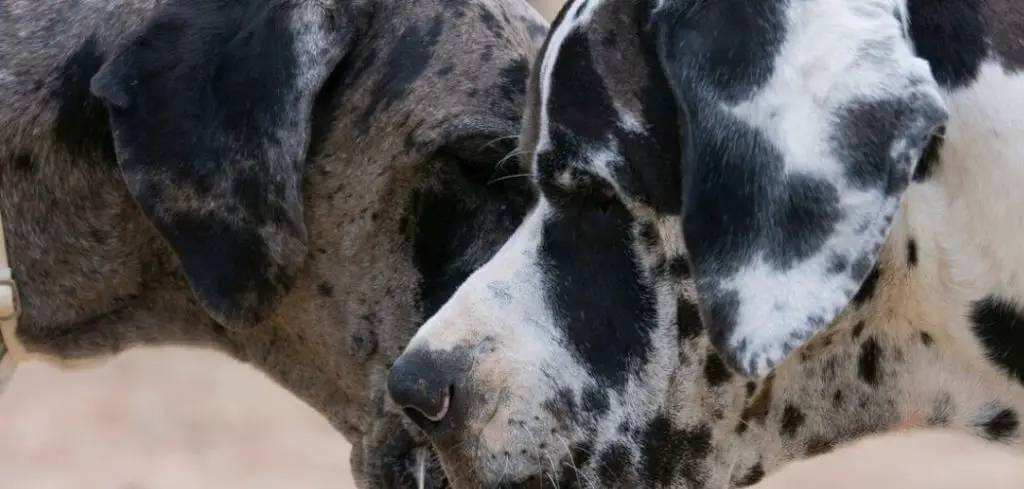Panting in dogs is normal, especially after exercise or in warm weather. But if your female dog is panting excessively while in heat (estrus), it could be a sign that something more is going on.
This behavior can be confusing and concerning to pet owners, especially if the panting doesn’t ease up.
We outline the common causes of a dog panting excessively in heat, what you can do at home, and when to seek veterinary help.
Dog Panting Excessively in Heat — Why It Happens
When a female dog is in heat and begins panting excessively, it can stem from hormonal changes, stress, pain, or even underlying health problems. Estrus can be an emotionally and physically intense time for some dogs. Increased anxiety, restlessness, and even mild discomfort are not unusual.
However, constant panting that doesn’t resolve could indicate fever, pain, uterine infection (pyometra), or behavioral distress.

Common Causes of Dog Panting Excessively in Heat
Hormonal Fluctuations
The heat cycle brings significant hormonal shifts in female dogs. These hormones can lead to increased body temperature, restlessness, and behavioral changes like pacing and panting.
Your dog might seem more anxious or unable to settle.
Panting is one way the body attempts to regulate internal heat and cope with stress. However, the panting should be mild and temporary. If it escalates or becomes constant, further evaluation is needed.
Read more: Dog Panting Excessively (Here’s why)
Anxiety and Behavioral Changes
Being in heat can make your dog feel on edge. She may seek attention, act clingy, or become more vocal.
Excessive panting is a common anxiety-related behavior. It can be a physical outlet for the hormonal agitation or frustration she’s experiencing.
You may notice pacing, whining, or attempts to escape or seek male dogs. This mental stress can manifest physically through panting.
Mild Pain or Cramping
Some female dogs experience discomfort during their heat cycle, especially during ovulation.
They may develop mild abdominal cramping or muscle soreness. Panting may accompany these sensations as a response to the discomfort.
Unlike a dog with pyometra or injury, a dog with mild cycle-related pain usually eats, drinks, and behaves normally otherwise. Still, watch for signs that pain may be worsening.
Pyometra (Uterine Infection)
A dangerous but important condition to rule out is pyometra — a life-threatening infection of the uterus.
It often occurs 1–3 weeks after the heat cycle, but symptoms can begin subtly during estrus. Pyometra causes panting, lethargy, vaginal discharge, fever, and loss of appetite.
This condition can progress quickly. Any dog panting excessively in heat who also seems ill should be seen urgently.
Fever or Systemic Illness
In rare cases, your dog may be fighting off an infection or illness unrelated to her reproductive cycle.
If she has a fever, her panting may be due to the body trying to regulate temperature. Look for other signs like shivering, weakness, or changes in eating and drinking habits.
Hormonal changes can suppress the immune system slightly, making dogs a bit more vulnerable during heat.
Environmental Heat or Dehydration
Sometimes the panting isn’t from estrus at all but due to environmental heat stress.
Dogs in heat may rest less, move more, and be more active as they seek out male dogs. This increase in exertion, combined with warm weather, could lead to overheating.
Always ensure your dog has a cool, quiet place to rest and plenty of fresh water.
What to Do If Your Dog Is Panting Excessively in Heat
Try to keep your dog as calm and comfortable as possible. Create a quiet, cool environment where she can relax. Avoid stressful interactions and limit physical activity.
You can offer her a fan or cooling mat to help regulate her body temperature. Make sure fresh water is available at all times.
If your dog seems overly anxious, some owners find pheromone diffusers or calming wraps helpful. However, consult your vet before giving any supplements or medications.
Keep track of how long the panting lasts. If it resolves in a few minutes or hours and she otherwise seems well, it’s likely tied to hormonal agitation.
On the other hand, if panting continues or is paired with vomiting, lethargy, poor appetite, or abnormal discharge, you should contact your vet promptly.
When to Call or Visit Your Vet
If your dog is panting excessively while in heat and you observe any of the following, it’s time to seek veterinary attention:
Vaginal discharge with pus or foul odor
Lethargy or listlessness
Refusing food or water
Vomiting or diarrhea
Bloated abdomen or signs of abdominal pain
Panting that worsens instead of easing
These could indicate pyometra, fever, heatstroke, or other complications. Prompt treatment is crucial.
Even if your dog seems otherwise well but the panting lasts longer than a day or interrupts her sleep, it’s best to get a checkup.
Read more: Dog Panting Excessively in Car (What it means)
Key Takeaway
Excessive panting during a dog’s heat cycle can be caused by hormonal shifts, anxiety, mild pain, or more serious health concerns like pyometra.
While some panting is expected due to stress or agitation, ongoing or intense panting needs close monitoring.
Create a calm environment, support hydration, and observe her closely. If the panting is accompanied by other worrisome signs, don’t wait to contact your vet. Early care can prevent complications and ensure your dog remains safe and comfortable during her cycle.
